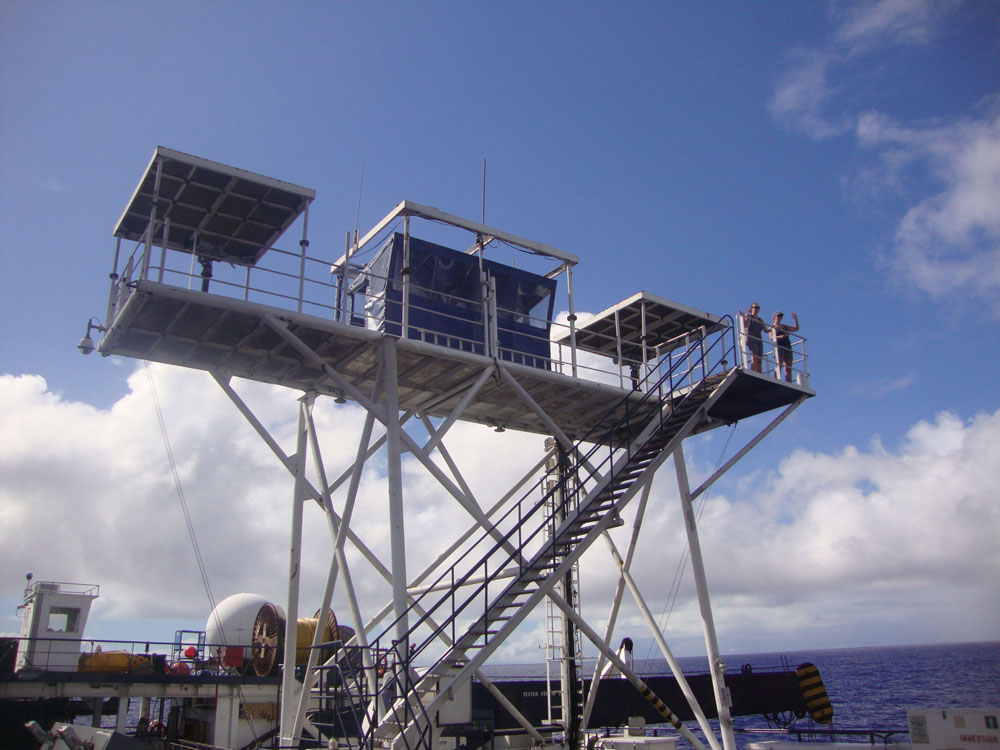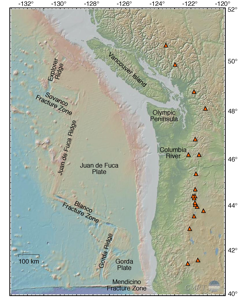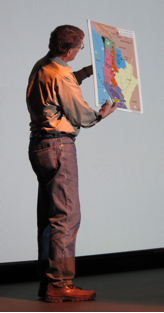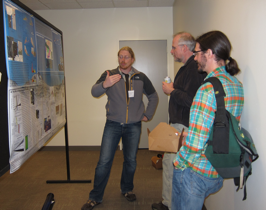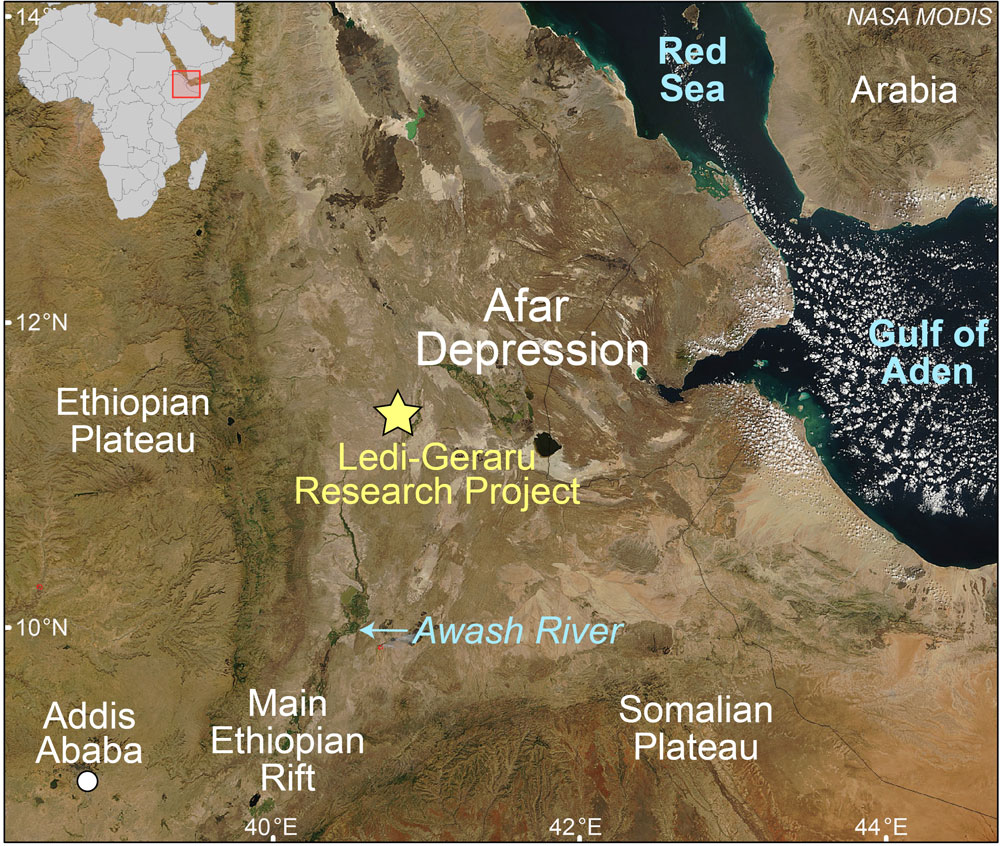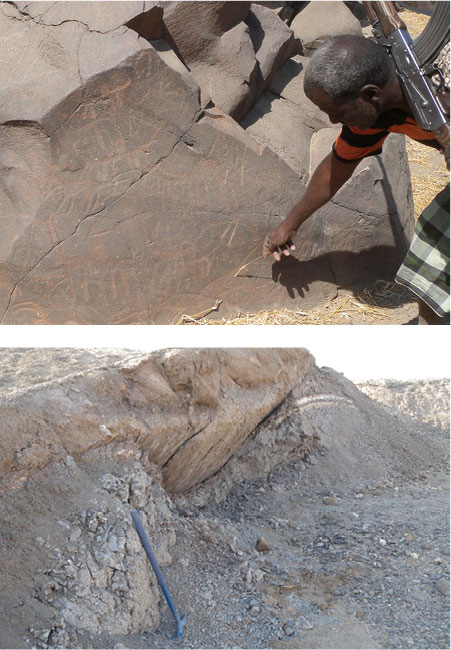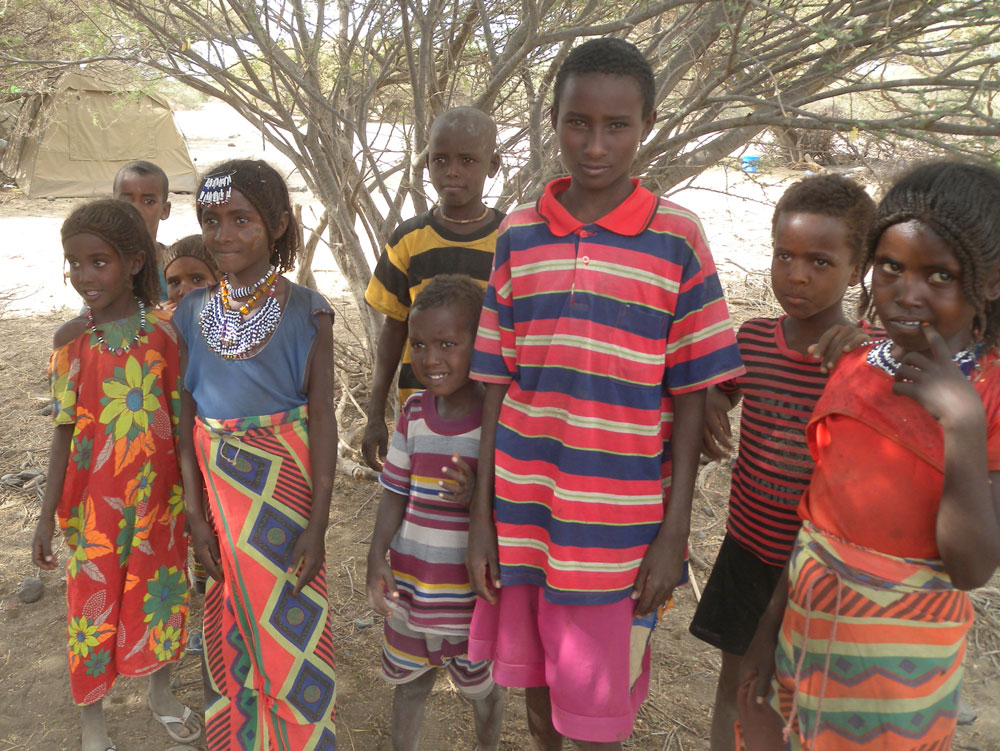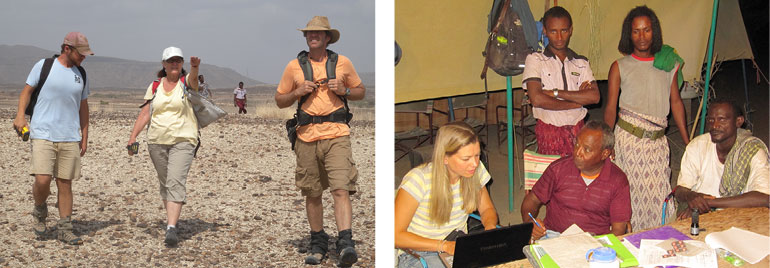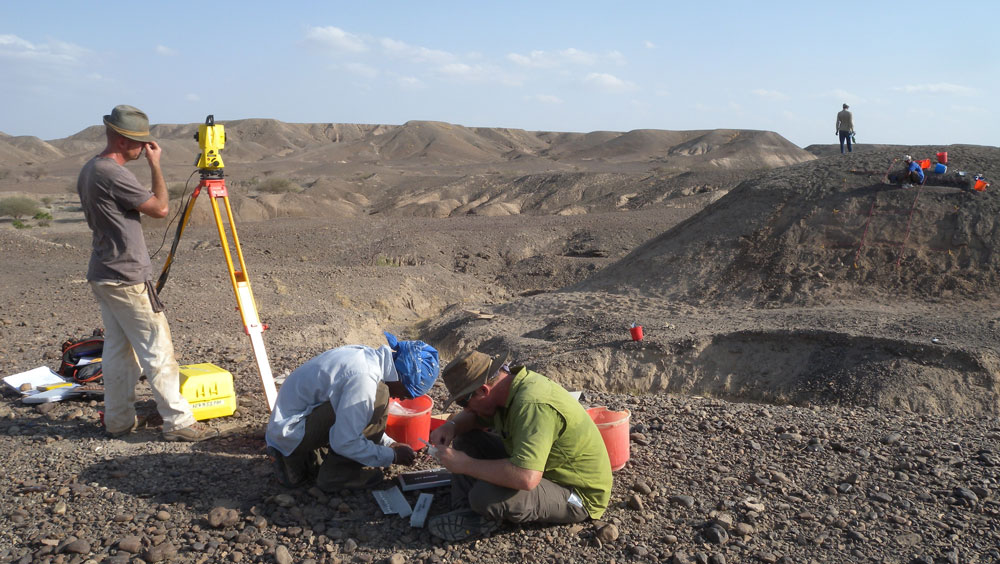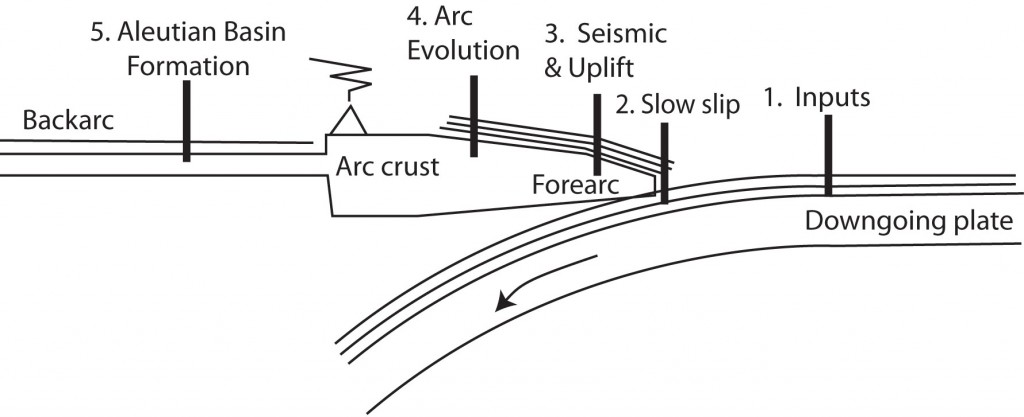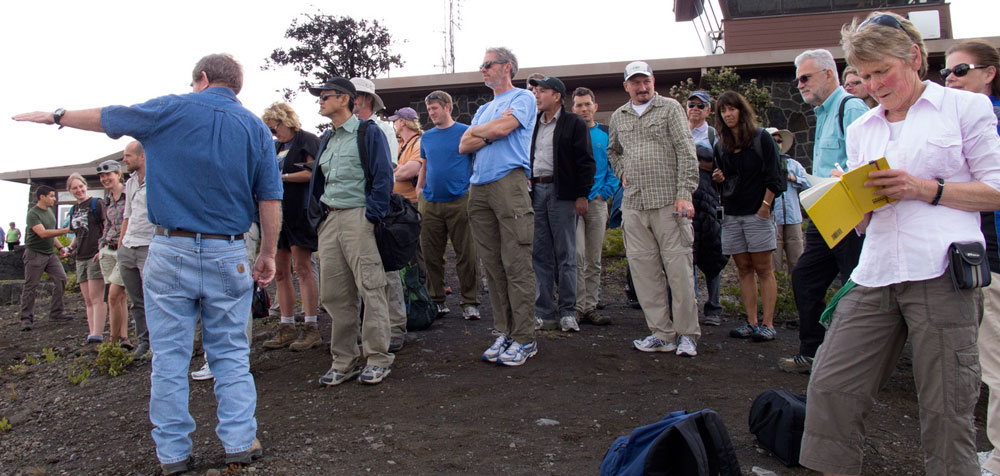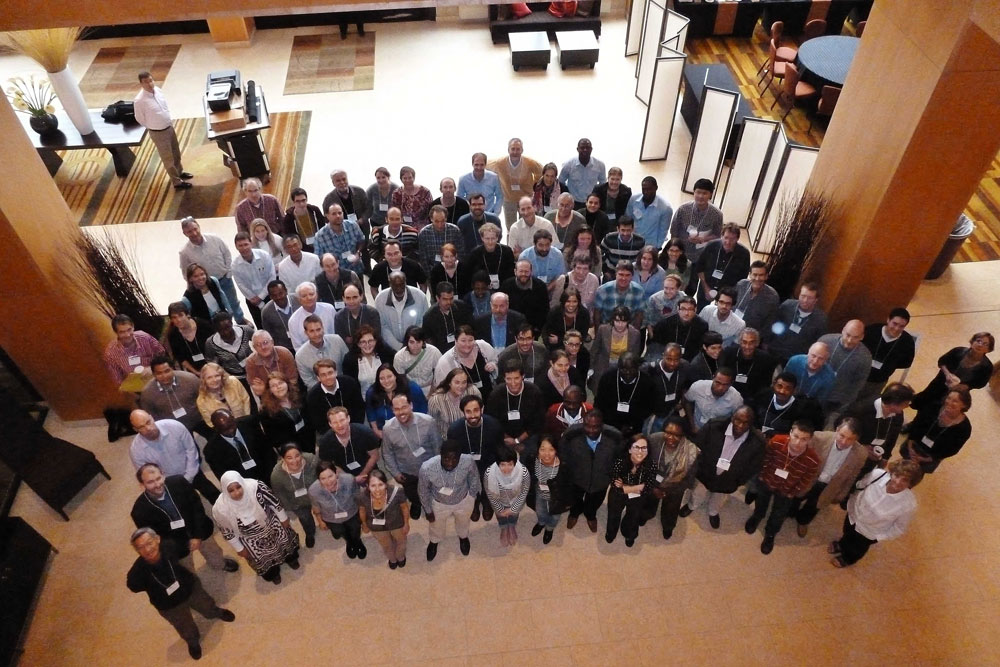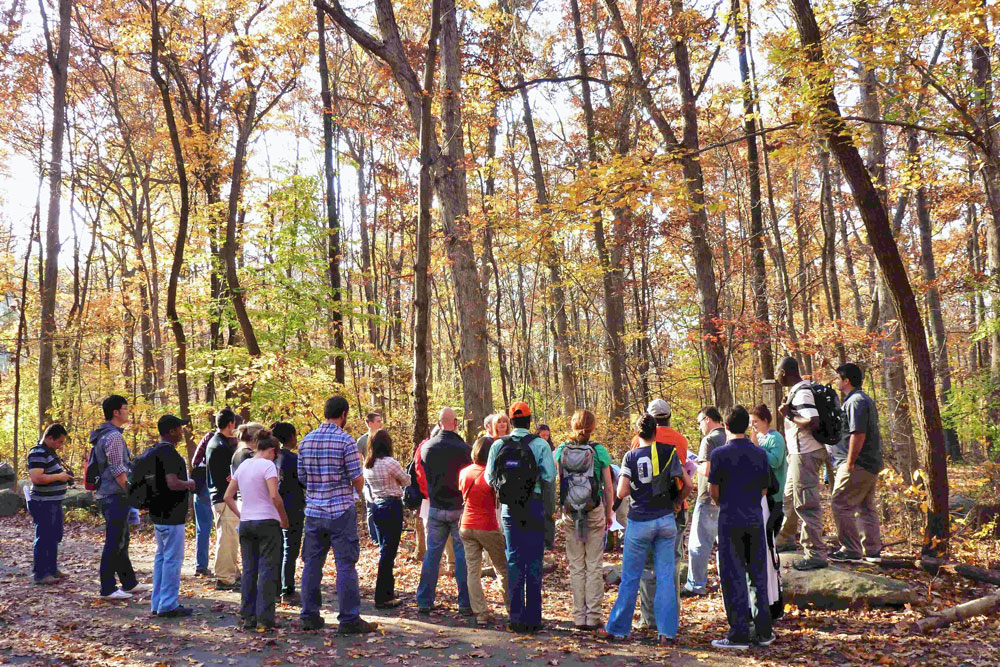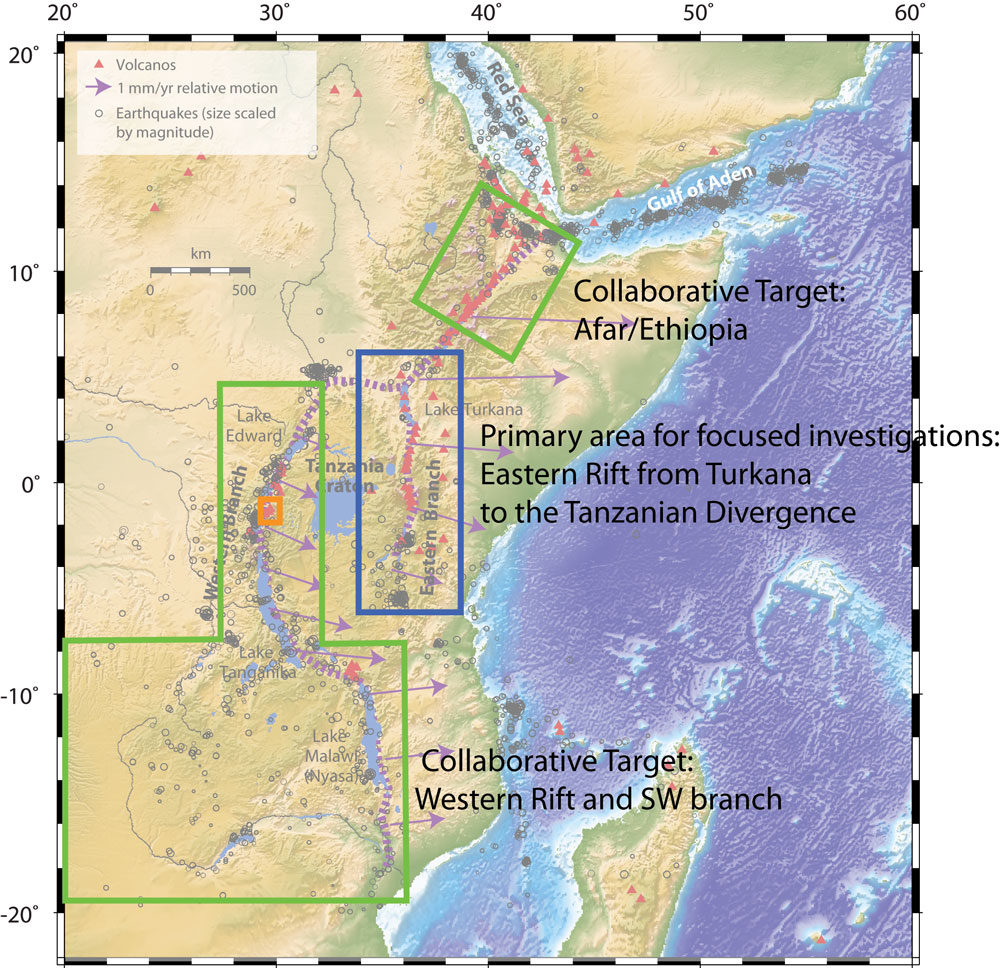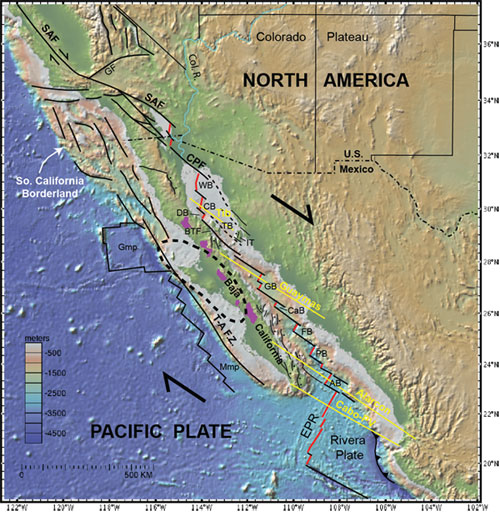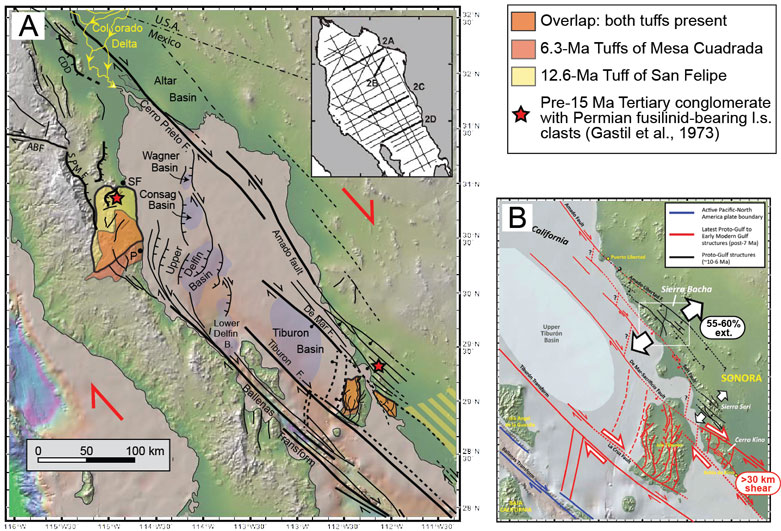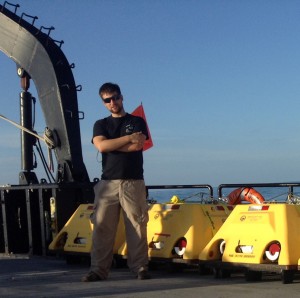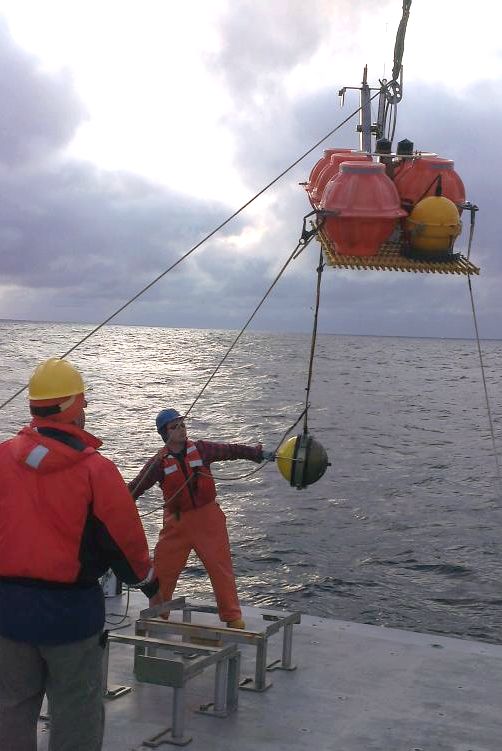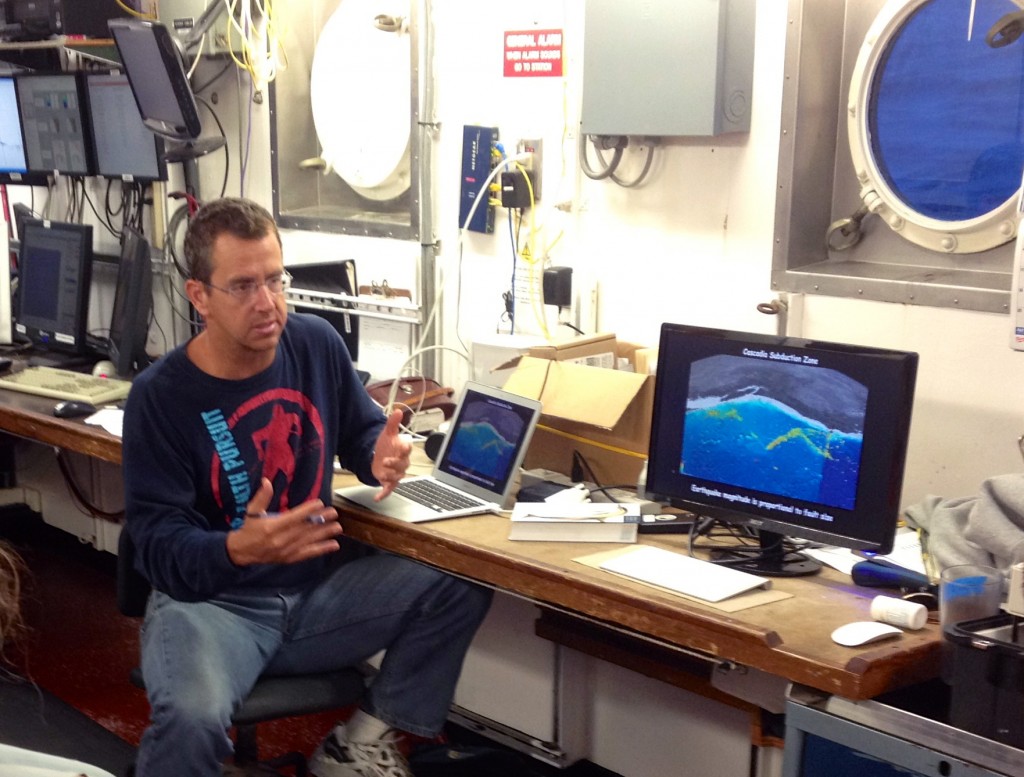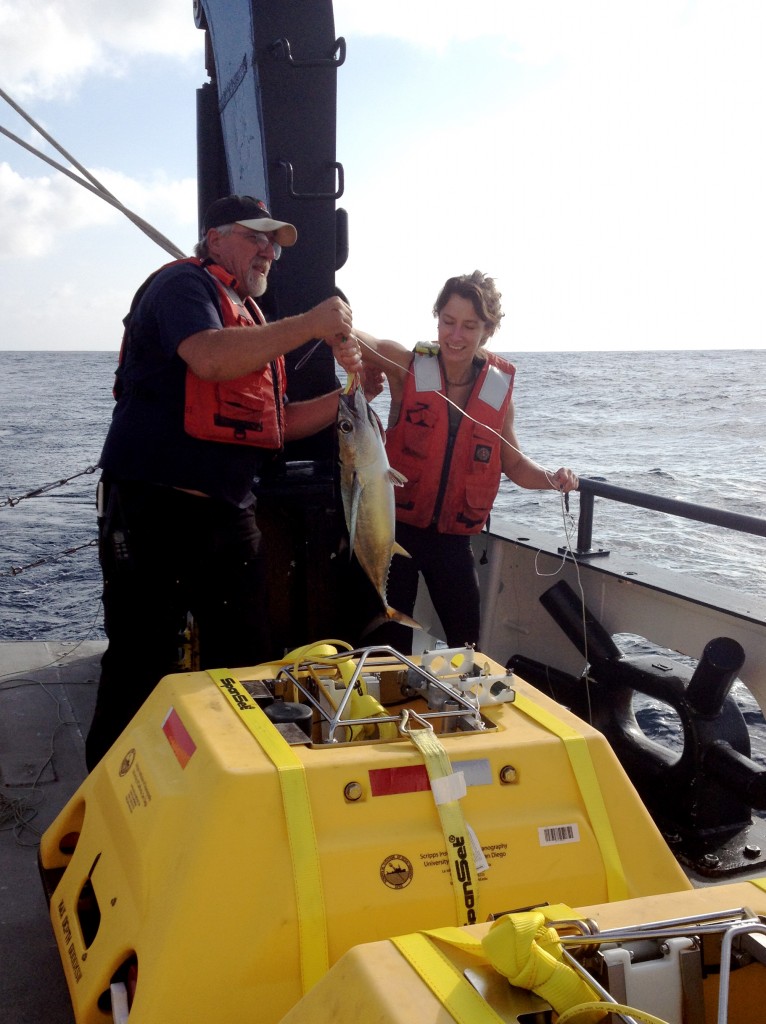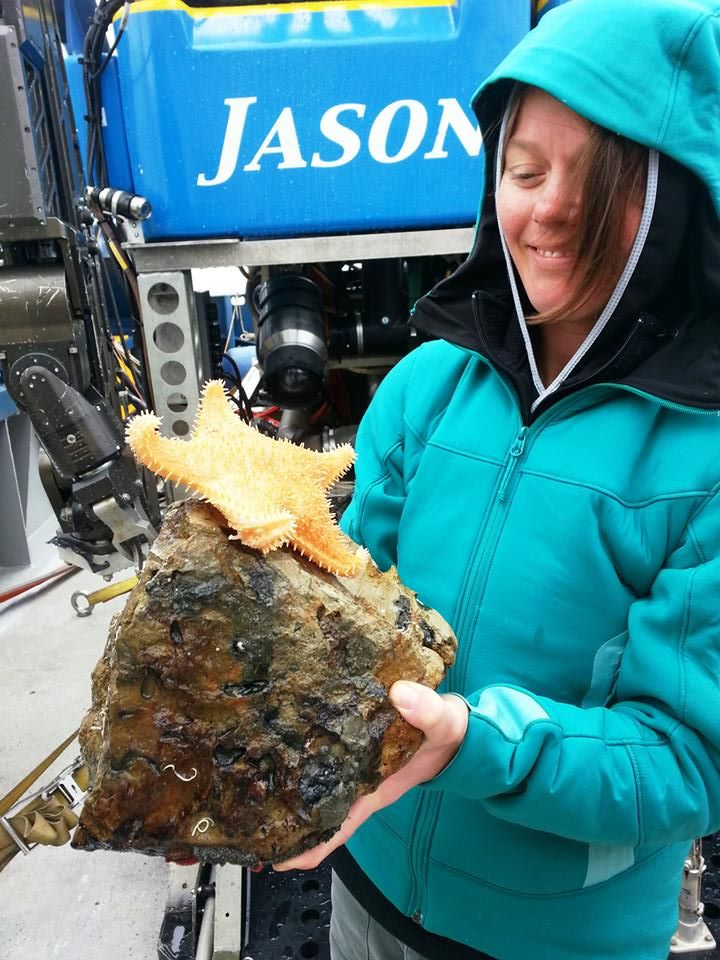1Lehigh University; 2WHOI; 3Rutgers University; 4University of Texas, Austin; 5ExxonMobil; 6University of Wisconsin; 7The College of New Jersey
Background and Motivations
The joint EarthScope-GeoPRISMS Eastern North America (ENAM) workshop held at Lehigh University from 26-29 October, 2011, with an attendance of ≈100 participants (Figure 1). EarthScope and GeoPRISMS represent research communities of geoscientists who study the processes that build continents, open oceans, and erode, transport and deposit sediments, along with the associated natural hazards of earthquakes, tsunamis, sea level rise, and landslides, both on land and under water. EarthScope science is undertaken primarily, but not exclusively on land and involves a facility of transportable and flexible arrays of seismometers with the primary goal of imaging the lithospheric and sub-lithospheric foundation of the United States. GeoPRISMS conducts shoreline-crossing interdisciplinary research to probe the processes that form and modify continental margins. Collectively, EarthScope and GeoPRISMS research provides an integrated framework for understanding the breadth of processes that govern continental formation, break-up, and evolution in the unique ENAM setting, and for assessing associated natural hazards and natural resources, in the US and Canada.
Further motivations for the convergence of interests in ENAM include the arrival of the EarthScope transportable array (TA) in 2012-13, while GeoPRISMS has identified ENAM as a primary site for research focused on rift initiation and evolution (RIE). The USGS also has been contracted to conduct a marine seismic survey of the US Extended Continental Shelf (ECS), tentatively in 2013. Concurrently, energy companies are showing a growing interest in the evolution of deep-sea margins, such as those along the eastern margin of North America. These activities offer distinct opportunities to leverage planned and potential onshore (e.g., USArray, FlexArray) and offshore (USGS or industry marine seismic surveys) programs. Therefore the timing is now ideal to organize the two communities and to identify the crucial science targets, and to develop or modify the strategies needed for science implementation for ENAM.
The GeoPRISMS community identified ENAM as a primary site to investigate rift initiation and evolution, in part because of the wide range of opportunities the geologic and geophysical setting provides for studying rifting and post-rift processes (figure 2). These include an apparent south to north transition from magma-rich to magma-poor break-up, numerous exposed and buried rift basins, thick archives of post-rift sediments and sedimentary rocks in shelf-slope basins, and well-documented surface processes. Similarly, ENAM appeals to the EarthScope community because of a long debated north to south transition in Appalachian structure, the west to east transition from craton to continental margin, the opportunity to investigate tectonic heredity in the context of continental assembly and dispersal, the emerging appreciation that sub-lithospheric dynamic mantle flow impacts surface dynamics, and the characterization of active seismic zones in a passive-margin setting.
An important goal of the science workshop was to focus the broader community effort on cross-disciplinary learning and approaches to collaborative science dedicated to the aforementioned science topics embodied in the archetypal passive margin. The workshop provided a national and international forum of scientists from universities, national laboratories, federal and state agencies, and industry, and included a colloquium and field trip specifically designed for early-career researchers including masters, doctoral, and post-doctoral scientists (figure 3).
Workshop Overview and Narrative
The workshop was constructed around two and one-half days of plenary presentations, short reports on “hot topics”, break-out sessions, and plenary discussions and decision making. Presentations and break-out sessions were organized around topics presented in participant white paper reports, and included: (a) orogenic processes, (b) rifting processes, (c) post-rift processes, and (d) neotectonic and surface processes. The break-out group attendance was designed to ensure diversity of thought, geographic interest, and synergy among the GeoPRISMS and EarthScope communities. Subsequent break-out discussions were defined by evolving participant interest in the geographic regions best suited to pursue the process-oriented science relevant to their field of study. Throughout the workshop, lively discussion ensued on how to best leverage the respective approaches of the GeoPRISMS and EarthScope communities in ENAM research.
Early in the meeting, we reviewed the EarthScope and GeoPRISMS Science Plans with particular focus on their implication for the Eastern North American Margin (ENAM). The EarthScope science plan and accompanying presentations of the 2009 science plan workshop articulate the key science targets for EarthScope research. Many of these science targets have direct relevance to ENAM, and presentations at the 2011 EarthScope National Meeting highlighted a range of scientific results from the study of these targets. More specific to ENAM was a 2004 EarthScope conference that focused on research frontiers and opportunities (http://www.earthscope.org/workshops/archive).
Similarly, the GeoPRISMS science plan (http://www.geoprisms.nineplanetsllc.com/science-plan.html) identifies rift initiation and evolution (RIE) as one of its initiatives. The implementation plan identifies ENAM as one of two RIE primary sites where the processes of continental rifting and transition to a passive margin will be studied. At ENAM, GeoPRISMS asks several interrelated questions regarding the distribution of lithospheric deformation, the influence of magmatism and pre-existing structural and compositional heterogeneity, the variation of rift structure and magmatism, the mantle dynamics of the syn- and post-rift margin, the processes that accompany the transition from late-stage rifting to mature seafloor spreading, how the margin has been influenced by post-rift tectonics, the identification of the magnitudes, mechanisms and timescales of elemental fluxes between the Earth, oceans and atmospheres along a passive margin during and after rifting, and characterizing the scales and frequency of submarine landslides and related natural hazards.
The first day of the meeting was dominated by plenary and hot-topic presentations that focused on building a content- and knowledge-base for ENAM from the wide range of geoscientific perspectives present at the meeting. Afternoon breakout sessions followed with a focus on the introduction of key research ideas and consideration of research corridors where the science could best be performed. What emerged out of this exercise was the organization of ENAM into three geographic regions: (1) a Northern area encompassing Atlantic Canada and New England; (2) a Mid-Atlantic region stretching from New York City to North Carolina; and (3) a Southern area stretching south from the Carolinas and wrapping around to the Gulf Coast.
The second day opened with breakout reports that articulated the geographic organization of science topics, followed by a slate of short presentations that focused on active tectonics, geodynamic modeling, and reports from aligned facilities, government organizations, and international partners. At this point, workshop participants were fully informed of the major science topics, high-interest focus areas, and opportunities for research synergy with community and industry partners. These presentations showed that the collective interests of university scientists, the USGS, and energy companies could provide a basis for a collaborative active-source seismic study offshore of the eastern United States, perhaps in the form of a jointly funded community experiment.
In the second round of breakout sessions workshop participants were charged with self-organizing into the three break-outs defined by geographic area, based on the results of the Thursday discussions. Nearly equal numbers of scientists attended the Northern and Southern geographic area break-outs, with a slightly larger proportion of participants attending the Central break-out. GeoPRISMS and EarthScope interests were similarly well-distributed among the three break-outs. In all groups, there was synergy across the shoreline among the terrestrial-based and marine-based geologists and geophysicists.
The relative size of the three geographic regions and the composition of the break-out attendees influenced the break-out discussions and the level of science implementation detail. The Southern break-out group restricted their consideration to the Atlantic margin to allow a purposeful overlap with the EarthScope TA. Similarly the Central group explored a number of potential shoreline-spanning projects because of the relatively restricted geographic area. In contrast, the Northern group was challenged with a greater diversity of interests and possible projects given its larger size. The deliverable from this third break-out exercise were focus areas, defined by polygons drawn on copies of the GSA Geologic Map of North America for the ENAM region (Figure 4).
Breakout reports followed that defined and presented the research corridors. The Southern group settled on a swath that stretched from eastern Tennessee, through South Carolina centered on Charleston, and out onto the shelf on the Blake Plateau. The justification for this line includes a classic cross section of the southern Appalachians, .incorporation of two seismic zones, including one that generated a historic M 7 earthquake, a traverse of rift basins that may contain the oldest syn-rift and post-rift sediments, a swath of the shelf that is underlain by potentially the oldest ocean crust, alignment with a funded mid-continent EarthScope project (OINK), and alignment with the Cape Fear Slide (CFS), perhaps the largest slide complex on the U.S. Atlantic margin.
The Central group defined two northwest-to-southeast mid-Atlantic focus areas, one in the south centered on Richmond, VA and one in the north centered on Philadelphia, PA. Both focus areas provide numerous opportunities for studying Appalachian structures, including the transition in deformation style from the northern Appalachians to southern Appalachians, Mesozoic rift basins, active seismic zones, and regions of documented recent deformation indicated by offset of deformed stratigraphic and geomorphic markers. They also take advantage of the thickest, richest, and best studied shelf-slope basin (the Baltimore Canyon Trough). The Richmond focus area has the added advantage of traversing early Cenozoic intrusive rocks. Given the close spatial position of the Richmond and Philadelphia focus areas, participants discussed the possibility of orienting a focus area parallel to the coast, centered more or less on the Fall Zone in an effort to take advantage of key features spanning the coastline in both the Philadelphia and Richmond areas. A north-south-oriented marine seismic line was also proposed that would link the extensive seismic and borehole data present across the continental shelf. As the U.S. Mid-Atlantic margins encompass the densest populations centers in ENAM, understanding the array of onshore and offshore geohazards are of particular concern for this region.
The Northern group defined a focus area centered on Nova Scotia that is positioned to take advantage of the well-known south to north transition from magma-rich to magma-poor continental margin. This focus area enjoys public access to an excellent Nova Scotia government-sourced database of industry seismic and well data for the Scotian basin, crosses the well-exposed Fundy rift basin, and shares a well-studied conjugate margin with Morocco. Notably, the EarthScope TA would have to be extended into Nova Scotia to take full advantage of onshore-offshore synergy. Nova Scotia is not currently part of the planned TA deployment, and modification to that plan will take effort and leadership by those individuals interested in studying this part of ENAM. The Northern group also defined a more narrow focus area stretching from the Adirondacks through southern New England and out onto the southern Georges Bank basin. There was considerable EarthScope geologic interest for study in this region, but it was not paired with equal enthusiasm for offshore research in the GeoPRISMS community, largely because the New England seamounts may overprint rift-related structure on the margin here.
Saturday morning opened with break-out reports for science implementation for the focus areas defined and supported on the previous day. There was lively discussion regarding how best to integrate field studies and data collection with several of the numerical models that had been presented. Discussion also ensued on which focus areas were best suited to leverage available resources and synergy with industry and community partners. There was an emerging sense that all of the focus areas had merit, but that there was greater potential for EarthScope-GeoPRISMS synergy in the Charleston and Nova Scotia focus areas, although lying outside the EarthScope study area challenged the latter.
At this point, the students were asked to give their perspective on the meeting, which included an independent evaluation of the science goals and prioritization of the focus areas based on those goals, inferred likelihood of success, and best opportunities for EarthScope-GeoPRISMS collaboration. The student report provided an objective summary of the workshop prepared by a group that was fully engaged in the process. They offered a rank order of the focus areas, with the best potential for EarthScope-GeoPRISMS collaboration as follows: Charleston, Nova Scotia, Richmond, Philadelphia, New England.
The student report was followed by short presentations and a panel discussion of ENAM broader impacts led by representatives of the GeoPRISMS and EarthScope outreach offices as well as David Smith, representing the Allentown, PA-based DaVinci Science Center. Collaborative EarthScope-GeoPRISMS research along the ENAM offers important opportunities to address a range of societal issues that can impact the most densely populated part of the nation. Natural hazard catastrophes are not in the collective memory of the nation with respect to ENAM, but in recorded history there have been very large, damaging earthquakes, and there is emerging, albeit controversial evidence for tsunamis. Other, related hazards include submarine landslides, potentially catastrophic clathrate degassing, fluid venting, sedimentation and erosion, flooding, and sea level rise. Infrastructure built along the North Atlantic margin range from wind power to telecommunications, and would be affected by such catastrophic events, as well as long-term sea level change. ENAM research also will contribute to the geotechnical considerations of siting the next generation of nuclear power plants, a dozen of which are operating, under construction, or ordered as of 2009-11. The Atlantic margin is a prime target for hydrocarbon exploration, motivating an improved understanding of past and present processes of the ENAM. Onshore and offshore basins and basalt flows are actively being evaluated as targets for carbon sequestration.
Finally, focusing efforts on the North Atlantic margins, particularly in eastern North America, opens the door for extensive education and outreach to US schools and universities active in Earth Science research.
Several opportunities were identified during the workshop for carrying out ENAM-wide synoptic studies, with a focus on those that would provide regional data sets that would benefit a wide range of GeoPRISMS and EarthScope researchers, i.e., the broader community. Specifically, there was discussion of the fate of the EarthScope TA once the planned deployment ends in 2015. Three main ideas were floated and discussed: (1) Plan to leave one in four TA instruments in ENAM and have these instruments adopted by state surveys, the NRC, and universities. This would provide for a widely spaced backbone (≈250 km) of instruments that could be densified by an FA for future EarthScope projects and OBS deployment for GeoPRISMS projects; (2) leave a 70-km spaced TA in place at one of the focus areas for more detailed, long-term studies of that region; (3) remove the TA completely and reassign the instruments to the FA pool for greater access and shortened wait times for smaller, more focused studies. The majority opinion was to exercise option (1), which is already taking place. A shorter discussion noted the opportunities for a parallel extension of a PBO GPS network. One EarthScope RAPID project has subsequently been successful in installing two PBO receivers on either side of the fault that ruptured in the 2011 VA earthquake.
A similar discussion was devoted to the possibility of a regional MCS and wide-angle survey along ENAM, leveraging planned USGS operations to conduct a seismic survey of the Extended Continental Shelf along the mid-Atlantic margin (see page 9, this issue). In addition, there was discussion about the future deployment of ocean bottom sensors as part of the Amphibious Array Facility (AAF) currently deployed along the Cascadia margin. The consensus was that the GeoPRISMS community needs to act now to demonstrate the interest to have these instruments move to ENAM when the facility leaves Cascadia. In the cases of future OBS or TA redeployment in ENAM, all participants agreed that one or more “heroes” will have to take up the cause and work closely with the community, NSF, IRIS, the USGS, and others to insure that there is lasting facility infrastructure in ENAM.


